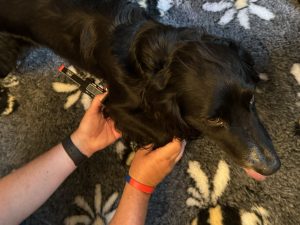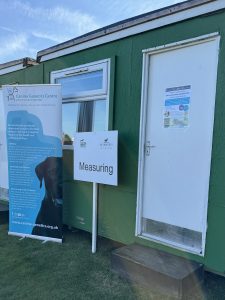 Last weekend we attended one of the largest Dog Agility shows in the UK, the Kennel Club International Agility Festival (KCIAF), where we met up with over 100 Cocker Spaniels. We were collecting data for research into Intervertebral Disc Disease (IVDD) as part of Bruno’s PhD.
Last weekend we attended one of the largest Dog Agility shows in the UK, the Kennel Club International Agility Festival (KCIAF), where we met up with over 100 Cocker Spaniels. We were collecting data for research into Intervertebral Disc Disease (IVDD) as part of Bruno’s PhD.
As part of a small grant that we were awarded by the Kennel Club Activities Health and Welfare sub-group earlier this year, we recruited a selection of competitive agility cocker spaniels (n=106) at the KCIAF. We are investigating the genetics involved in IVDD, and whether genetic risk factors differ between small and medium dogs. Throughout Thursday, Friday and Saturday we collected DNA samples and undertook ulna/back length measuring of a selection of competing cockers. The cockers represented both the small (n=33) and medium (n=72) height categories with all dogs competing at grade 4 and above.
A single person measured every single dog as it has been shown that the reliability of these measurements is high when performed by a single person, but decreases when multiple people are used(1). The ulna was measured using a digital device, and measurements for both front legs was recorded and then an average. Over all the dogs, the range of ulna length varied from 79.95mm to 208.70mm. Two different back length measurements were taken – withers to base of tail (31-49cm) and then withers to end of rib cage (12-24cm).
We have a lot of data to analyse and we will be selecting 50 samples (25 small; 25 medium) to genotype for the IVDD genetic risk factors to study the allele frequency in a UK cocker population, so watch this space for further updates.
 We would like to thank all the competitors who took time out of their busy days to join in with our data collection, all the spaniels that gave us lovely fuss and waggy tails and of course, the KCIAF organisers for their hospitality and support.
We would like to thank all the competitors who took time out of their busy days to join in with our data collection, all the spaniels that gave us lovely fuss and waggy tails and of course, the KCIAF organisers for their hospitality and support.
References
- Burbidge H M et al. The accuracy and reliability of linear measurements of the ulna for anthropometrical studies in dogs. Res Vet Sci, 1998 Jul-Aug;65(1):53-7.

